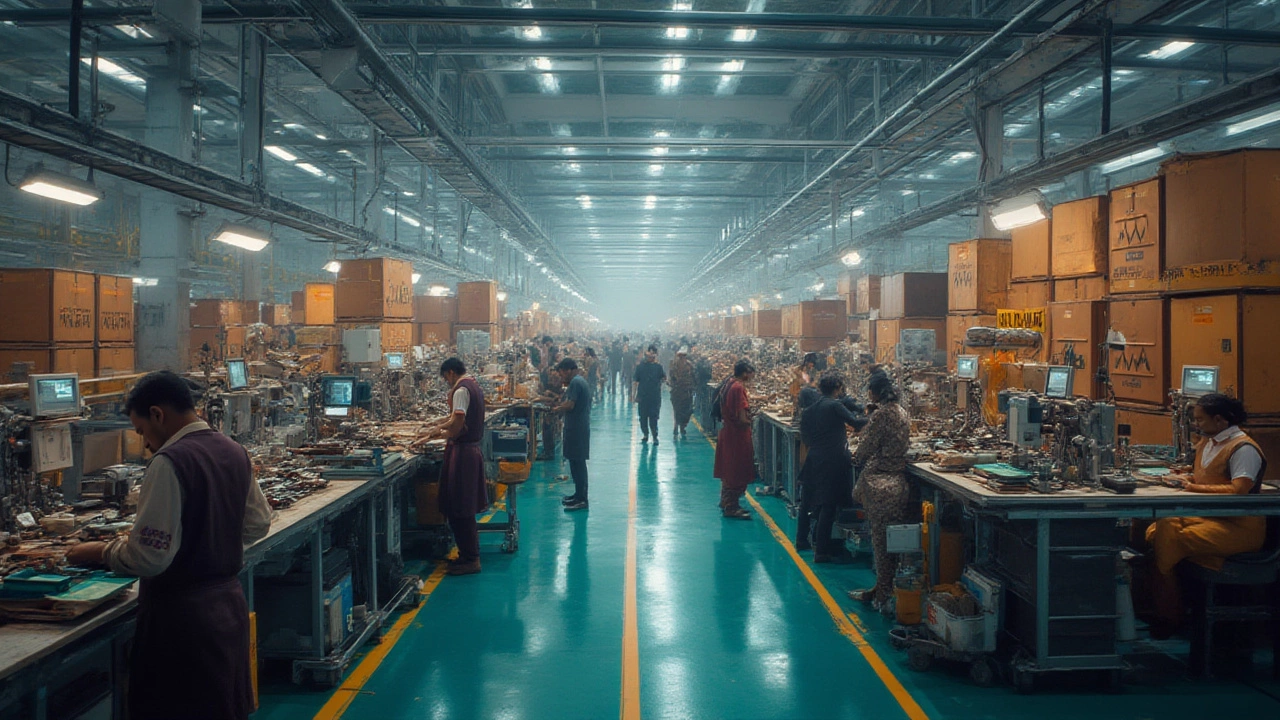Ever wondered where your phone, car, or even T-shirt came from? Maybe you're picturing a faraway place with endless factories humming along, churning out almost everything you see in the store. That's not just your imagination—there really are a few giants that shape the modern world by powering global manufacturing at a mind-boggling scale. Today, let's pull back the curtain and spotlight the true titans of industry, digging deep into who really holds the title of the world's biggest manufacturer—and why.
The Global Manufacturing Landscape
Walk into almost any shop in the world, and you’ll spot ‘Made in China’ labels more often than not. It’s not an accident. China isn’t just big in manufacturing—it is by far the largest manufacturer on the planet. The numbers say it all: according to World Bank data from 2024, China’s manufacturing sector contributes over $4 trillion to its GDP, accounting for about 28% of the total global manufacturing output. That’s more than the next several countries combined. No one comes close—not even the United States, which firmly holds second place with about $2.3 trillion, nearly half China’s figure. The gap between these two is one of the major stories shaping world economies and job markets today.
But how did China get here? It wasn’t always the king of manufacturing. Back in the 1980s and early 1990s, the US wore the crown. Then, as China started opening its economy and encouraging foreign investment, companies around the world set up shop there. Lower labor costs, speed, and a "get it done" attitude helped China zoom ahead. It’s like if you gave a factory an energy drink—and a million more workers. Add a government that loves to support industry, and you’ve got a recipe for a powerhouse.
Now, it’s not just China and the US in the mix. Japan, Germany, South Korea, and India all bring something special to the table. Japan dominates high-tech electronics and automobiles, Germany is known for superb engineering and automotive brands, while South Korea has become a champion in semiconductors and shipbuilding. India isn’t quite as big yet, but with a young population and ambitious growth plans, it’s aiming for the top five soon enough.
Check out this quick snapshot of global manufacturing shares, based on UNIDO and World Bank 2024 data:
| Country | Manufacturing Output (USD Trillions, 2024) | Global Share (%) |
|---|---|---|
| China | 4.2 | 28% |
| United States | 2.3 | 15% |
| Japan | 1.0 | 7% |
| Germany | 0.9 | 6% |
| South Korea | 0.5 | 3.5% |
| India | 0.5 | 3.5% |
To put that in perspective, China’s factories crank out nearly one-third of everything manufactured worldwide—from smartphones to toasters to electric vehicles. Still think your clothing label is just a fluke?
These countries all specialize in different areas, but China’s sheer scale and diversity are unmatched. There's even a saying among global supply chain managers: "If it's not made in China, it's made with something from China." The country’s network of suppliers and manufacturers is like a vast, intricate web—cut one strand and the whole thing wobbles.
What Drives the World’s Biggest Manufacturer?
It’s not just China’s population or cheap labor costs (though those help). The secret sauce is a combination of investments in infrastructure, technology, and relationships. Those gigantic ports you see in Shanghai and Shenzhen aren’t just tourist attractions—they’re moving millions of shipping containers each year. The Chinese government has poured money into these hubs, meaning parts and products zip through faster than anywhere else on earth.
And don’t overlook the relentless focus on supply chains. Huge cities like Guangzhou and Suzhou have clusters of specialized factories: one area might focus on electronics, another on textiles, yet another on batteries or chemicals. It’s like a super-efficient jigsaw puzzle, where each piece is close to the other—logistics become faster and cheaper. This clustering isn’t just for convenience; it gives Chinese manufacturers the edge when a company wants to launch a new gadget or a fashion retailer needs the hottest style delivered yesterday.
But as Chinese wages grow, the story is changing. Automation is speeding up, with factories swapping human hands for nimble robots, especially in big urban centers. The city of Dongguan, known for its massive toy and electronics factories, now looks almost like a sci-fi lab. Think conveyor belts with zero humans in sight. It’s not science fiction; it’s today’s reality.
Then there’s the government itself. From tax breaks to subsidies and innovation grants, the Chinese state has taken a hands-on approach. According to a report from McKinsey & Company in 2024, about 40% of all Chinese industrial R&D spending comes from some level of government support. “China’s drive to lead in robotics, EVs, and green tech is no accident—it’s a direct result of focused policy with deep state backing,” says McKinsey’s head of manufacturing research.
Oh, and you can’t forget about factories that are literally large enough to have their own bus routes. The Foxconn factory complex in Zhengzhou—sometimes called ‘iPhone City’—employs around 300,000 people at its peak. Imagine a workforce the size of an entire mid-sized city, all dedicated to making phones and parts. The numbers almost don’t feel real.
If there’s a downside for China, it’s environmental strain. The more they produce, the bigger the challenge of pollution and resource management. The government’s ramping up efforts to go green, and green tech is now big business in itself. As the saying goes, “Factories move fast, but so does the smog.” That’s why China is betting big on electric vehicles (EVs) and solar panels; they don’t just want to make them—they want to dominate the world’s supply.

United States and the Rise of Specialized Giants
Let’s not count out the United States, though. While it doesn't make nearly as much stuff as China, it’s got some tricks that others envy. US manufacturing excels in value-added products—think aerospace telescopes, advanced semiconductors, the latest electric cars, and industrial machinery. Classic brands like Boeing, Caterpillar, and Ford may not pop out billions of cheap gadgets, but they create products that are difficult to copy and in high demand around the world.
The US has fewer large mega-factories than China. Instead, it’s a patchwork of midsize and highly automated plants linked to advanced research centers. Ever heard of Tesla’s Gigafactories? These monsters cover square kilometers of ground—massive, yes, but focused purely on next-gen batteries and cars. Each one could make you feel like you’ve stepped onto a set from the movie "Blade Runner."
The value in US manufacturing isn’t just in assembling parts—it’s about creating and keeping secrets. Advanced jet engines, biotech gear, and smart machines often start life in a US lab or factory, protected by patents and tightly controlled supply chains. As a friend of mine who’s an engineer at a Silicon Valley startup likes to say, "We make less, but we make the magic stuff."
This doesn't mean everything is rosy. Since the 1990s, jobs in manufacturing have dropped—even as output kept growing—because a lot of simple assembly work has shifted offshore or been replaced by machines. The upside? When tech leaps forward, American innovation often leads the charge. According to the National Association of Manufacturers, US factories still account for over 60% of all private sector R&D in the country. Think of them as the secret science labs of global industry—maybe sometimes less visible, but totally necessary.
"Innovation distinguishes between a leader and a follower." — Steve Jobs, Apple Inc.
Plus, the US is a giant in aerospace and pharmaceuticals. Boeing’s airplanes crisscross the skies in just about every nation, and pharmaceutical giants like Pfizer and Johnson & Johnson ship medicines to all corners of the planet. Even in the smartphone business, every iPhone still depends on parts and know-how that originate in the States.
Another fun fact: while China dominates the world's factory floor, the US is home to the world's largest single-site manufacturing plant by floor area—the Boeing Everett Factory in Washington State covers an insane 98 acres under one roof. If you ever visit, you’ll see rows of airplanes in different stages of assembly, some so big they look like skyscrapers with wings.
Hidden Powerhouses: How Other Countries Stack Up
Let’s look beyond the two heavyweights—because global manufacturing is more than just China and the US. Japan, for instance, is a silent master of quality. Brands like Toyota, Sony, and Panasonic have set standards people trust. It’s not just about making things in bulk; attention to detail and precision are part of Japanese industry culture. Japanese factories invented concepts like “just-in-time” production—basically, making what you need, when you need it, which cuts down on waste and keeps customers happy.
Germany is the proud home of engineering excellence. Mercedes-Benz, BMW, Volkswagen—they’re all German, and their cars are loved worldwide for good reason. German machinery is so reliable that American, Chinese, and Indian factories buy it for their own production lines. My own family once owned an old Mercedes that outlasted almost everything else in our garage—proof of that reputation.
South Korea’s story is a little different. It doesn’t match China or the US in size, but it punches way above its weight when it comes to semiconductors (thanks, Samsung and SK Hynix), displays, ships, and more recently, electric cars. If you love your flat-screen TV, chances are it’s from South Korea. Each of these countries has carved out a niche and built sprawling supplier networks.
And don’t dismiss India. While not a global leader—yet—the country is racing to attract foreign investors and tech companies looking to diversify away from China. Mobile phone factories run by Foxconn and Samsung have cropped up across India, producing millions of devices yearly. Plus, with a huge young workforce willing to learn, India’s "Make in India" initiative is aiming to grab a bigger piece of the pie. Tata Group, Mahindra, and Bajaj Auto are some Indian manufacturers you might spot next time you’re at a dealership or tech expo.
Italy and France deserve a shout-out too. They may not lead in volume, but when it comes to fashion, luxury goods, and specialized machinery, they’ve got that covered. Think designer handbags, world-class shoes, and super-precise metalworking tools that end up in factories around the world.
Here's a quick chart for some of the major specialties by country (based on latest industry reports from 2024):
| Country | Main Manufacturing Sectors |
|---|---|
| China | Consumer electronics, textiles, appliances, EVs, machinery |
| United States | Aerospace, semiconductors, automotive, biotech |
| Japan | Automotive, electronics, robotics |
| Germany | Automotive, industrial machinery, chemicals |
| South Korea | Semiconductors, displays, ships |
| India | Textiles, automotive, pharmaceuticals |
| Italy | Fashion, textiles, machinery |
| France | Luxury goods, automotive, aerospace |
Global manufacturing means more than giant factories. Often, it’s about deep traditions, skilled workers, and companies that focus relentlessly on improvement—even if that means refusing to cut corners.

The Big Picture: Jobs, Tech, and What’s Next
The biggest manufacturers don’t just make stuff—they shape how we live. The smartphone in your pocket probably took a trip around the world before reaching you. Parts from Japan, chips from South Korea, assembled in China, designed in the US. It’s a true team effort—though some players have bigger roles than others.
That said, job numbers are shifting. China still has the world’s largest manufacturing workforce by far, with over 110 million people involved in making everything from shoes to spaceships. But jobs are starting to thin out in urban centers as automation takes over. When I talked to a friend who recently visited Dongguan, he said, “Some factories are so quiet now, you can hear your footsteps echo.” Sure, jobs don’t disappear overnight, but anyone dreaming of standing at an assembly line for decades may need to rethink things.
The United States has lost millions of traditional factory jobs since the late 20th century, but it’s gained new ones in places like robotics, automation, and logistics management. German and Japanese companies, meanwhile, focus on integrating AI and top-tier engineering skills, so their workers are less likely to be replaced by robots—at least for now.
Supply chain resilience is the buzzword of the decade. The COVID-19 pandemic, bottlenecks in shipping, and new geopolitical tensions have all pushed manufacturers to rethink just-in-time delivery and start keeping more inventory or building extra factories in different regions. This is why manufacturers are considering “China plus one” strategies—keeping a major presence in China, but opening secondary plants in Vietnam, India, or Mexico, just in case.
Now, let’s talk tech. The biggest manufacturing trend in 2025? Green everything. From batteries to solar panels to electric cars, countries are chasing new standards for energy efficiency and carbon footprint. China leads in solar and EVs—the world’s largest market for both—while the US and Germany push tech for clean hydrogen and next-gen alloys that could be game changers. Factories are using AI to spot defects and drive down waste. If you think “factory” means smoke and grime, you haven’t seen a modern chip plant—think rooms cleaner than a hospital and people in head-to-toe white suits controlling machines worth billions.
Still, no one gets a free pass. Environmental rules are tightening everywhere. Consumers care more than ever about who makes things, and how. Mark my words: the next wave of manufacturing bigwigs will win by proving their green credentials, not just by cranking out more widgets.
"The future belongs to those who prepare for it today.” — Malcolm X
So, who is the biggest manufacturer in the world? China, hands down. But it’s not just about the raw numbers—it’s about strategies, innovation, and adaptability. If you’re thinking about diving into the world of manufacturing, watch what the industry leaders do next, not just what they did yesterday. They’re drawing the map for the next century, and anyone with sharp eyes can learn a lot just by following the trail.
